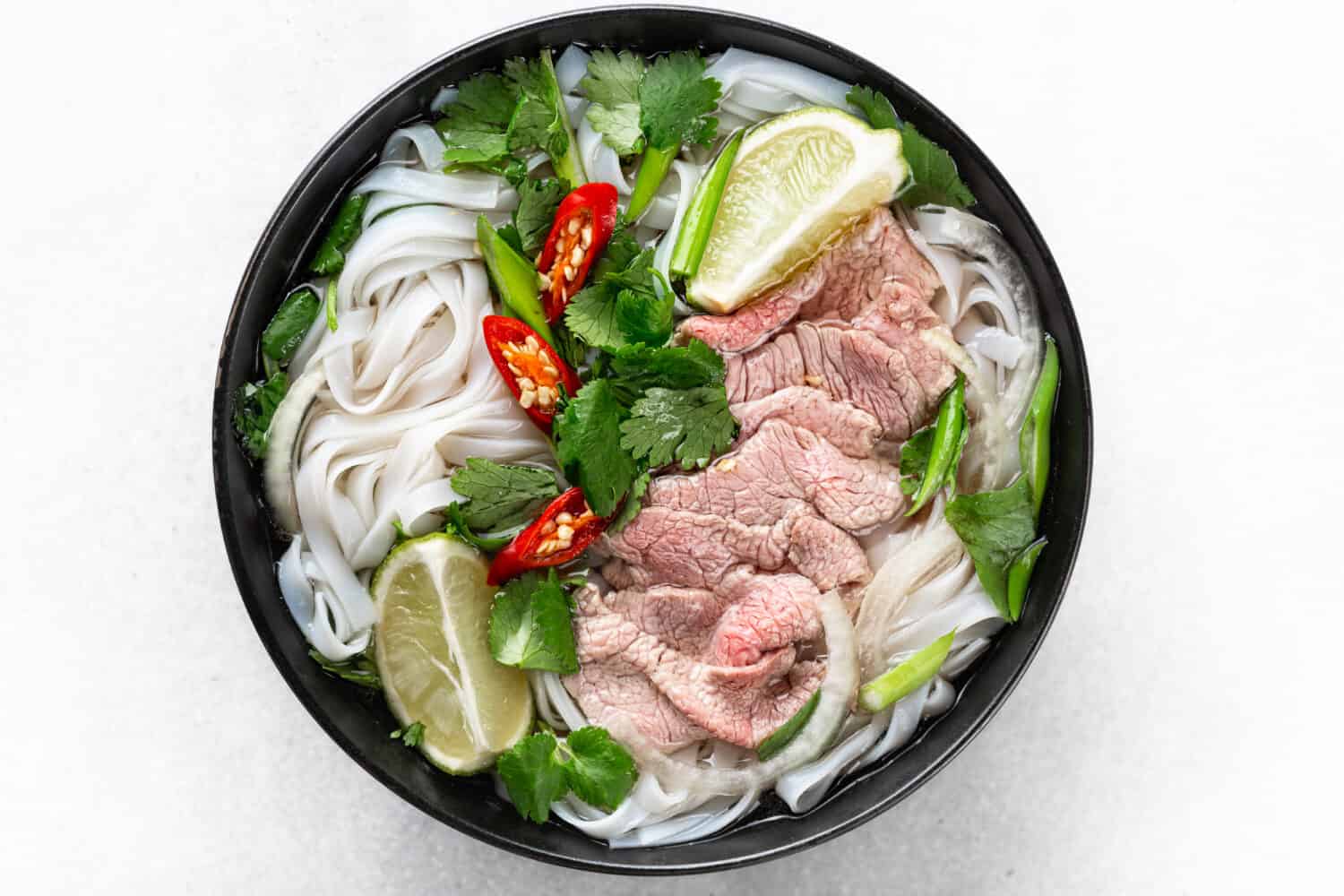Pho (pronounced fuh) is a popular Vietnamese dish many enjoy worldwide. With its delicious broth base and combinations of herbs, rice noodles, and meat, it hits the spot! One of the common questions that one asks is: is pho healthy? The answer to that question is yes, but it is also more complex than yes or no. It is true that pho contains plenty of nutritional benefits and is, in fact, pretty healthy. However, whether or not you are eating a pho soup that gives you the best nutrition possible will depend on several factors. These include the herbs, meat, broth, whether or not the pho is homemade or prepackaged, and more.
This article will look at the health benefits of consuming pho (there are plenty!) as well as a few downsides and what you can do to ensure your pho is as healthy as possible!
What is Pho?
Pho is a Vietnamese soup that garnered popularity as a street food. However, many people enjoy pho worldwide, and its versatility allows it to be made at home and in restaurants.
Traditionally, pho consists of bone broth, rice noodles, meat, and various herbs. The toppings vary as well, from sliced chilis to lime. There are many possibilities!
Pho is highly nutritious, given the bone broth and herbs in it. However, there are a few downfalls, such as high sodium and a higher calorie intake.
How is Pho Made?
Before we get into traditional pho's nutrition profile, let's look at how it is typically made. Pho is an aromatic comfort food that so many love. The herbs are pleasing, and the flavor packs many unique qualities.
The first step involves simmering the beef or chicken bones and a variety of spices with ginger and onions to make the bone broth. Some skip this step and buy already-made bone broth from the store.
After the beef bone broth, it is poured over slices of meat and cooked rice noodles. Afterwards, you can garnish with many different toppings!
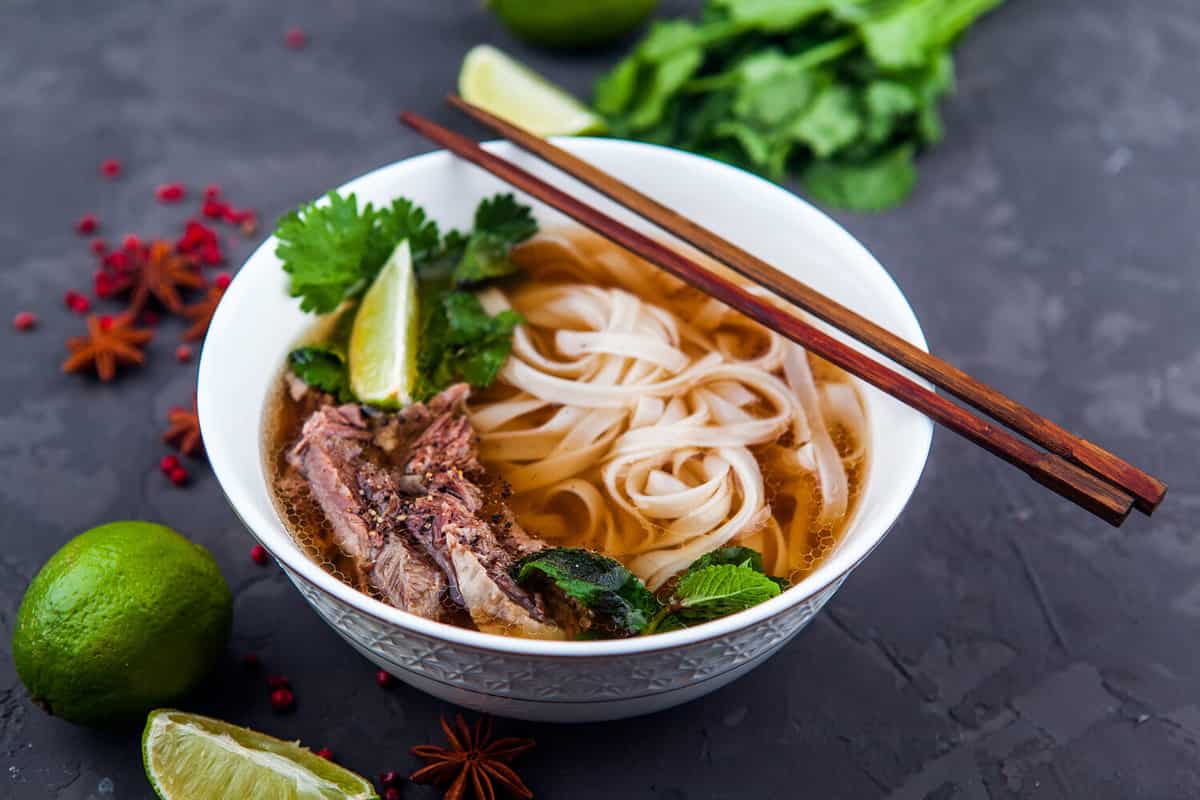
Pho is a hearty and filling noodle soup that many enjoy worldwide. It is versatile and packs plenty of nutrients!
©CheDima/Shutterstock.com
The Health Benefits of Pho
Pho contains plenty of health benefits because of the ingredients it has. For starters, it is naturally gluten-free. This means that those with sensitivities and intolerances to gluten can take in all the health benefits that pho has to offer without worrying about gluten. Since there are many benefits to discuss, we will look at each ingredient individually.
Bone Broth Benefits
The base of pho consists of bone broth. When it comes to pho, there are a few different types. Two of the most common are pho ga, which is chicken pho, and pho bo, which is beef pho. The type of pho you make will determine what bones you use for the broth. However, regardless of which pho, there are plenty of health benefits that come with consuming bone broth. These benefits include:
- Bone broth contains many necessary vitamins, including calcium, iron, zinc, and selenium.
- Beef and chicken bone broth can aid in digestive health.
- Bone broth may increase possible joint health benefits.
- Another benefit includes aiding in better sleep quality.
- Bone broth may also reduce inflammation.
Herb Benefits
Common herbs in pho are Thai basil, cilantro, mint, cilantro, Thai chili, and rice paddy herbs. These herbs pack plenty of health benefits. While the benefits will vary depending on the herbs used in each pho recipe, they may aid in:
- Many herbs may aid in reducing the risk of cancer.
- Herbs can reduce the risk of heart disease.
- Herbs may also help in reducing inflammation.
- Many herbs can help with fighting infections.
- Herbs can also increase immune system function.
Rice Noodle Benefits
Rice noodles are commonly in pho soup. They are naturally gluten-free and have a mildly sweet flavor and chewy texture. Some benefits of eating rice noodles include:
- Rice noodles contain selenium, which helps thyroid function.
- Rice noodles are low in sodium, which improves overall heart health.
- This type of noodle is naturally gluten-free, which allows those with sensitivities and intolerances to enjoy pho.
Meat Benefits
A common ingredient in pho is thinly sliced meat. This meat will vary depending on the pho dish. However, the common meats are beef, chicken, and seafood. Potential health benefits of these include:
- Meat is a good source of protein, which helps with strength.
- Beef contains zinc, iron, phosphorus, and Vitamin B12. At the same time, chicken contains selenium, zinc, potassium, and phosphorus. Seafood, mainly fish, contains omega-3 fatty acids, iodine, and more.
- Beef protects against anemia.
- Chicken and seafood may aid in heart health.
These are only a few benefits that chicken, seafood, and beef carry.
Common Toppings and Benefits
Among the many ingredients that pho contains, some standard toppings and additives also boast plenty of health benefits:
- Ginger: ginger has many health benefits. These include curbing nausea, aiding in osteoarthritis symptoms, lowering blood sugar, and reducing the risk of heart disease.
- Onions: Onions carry many nutrients, including Vitamin C and potassium. They can also help with kidney function and heart health and help regulate blood sugar.
- Fish Sauce: Fish sauce contains animal proteins.
- Star Anise: Star anise contains shikimic acid, which can help treat viral infections. Stair anise may also aid in stopping bacteria from growing as well.
- Scallions: Scallions are low in calories and contain fiber, Vitamin C, and folate.
- Bean Sprouts: The benefits of bean sprouts depend on the type used. However, many benefits include melatonin (which helps the body relax and fall asleep easier), antioxidants, and protein.
- Lime: Lime contains antioxidants, which are great for protecting cells and reducing the risk of heart disease and diabetes. LIme may also help with immune function and iron absorption.
Of course, there are plenty of ingredients that pho soup may contain! These are just several of the most commonly used.
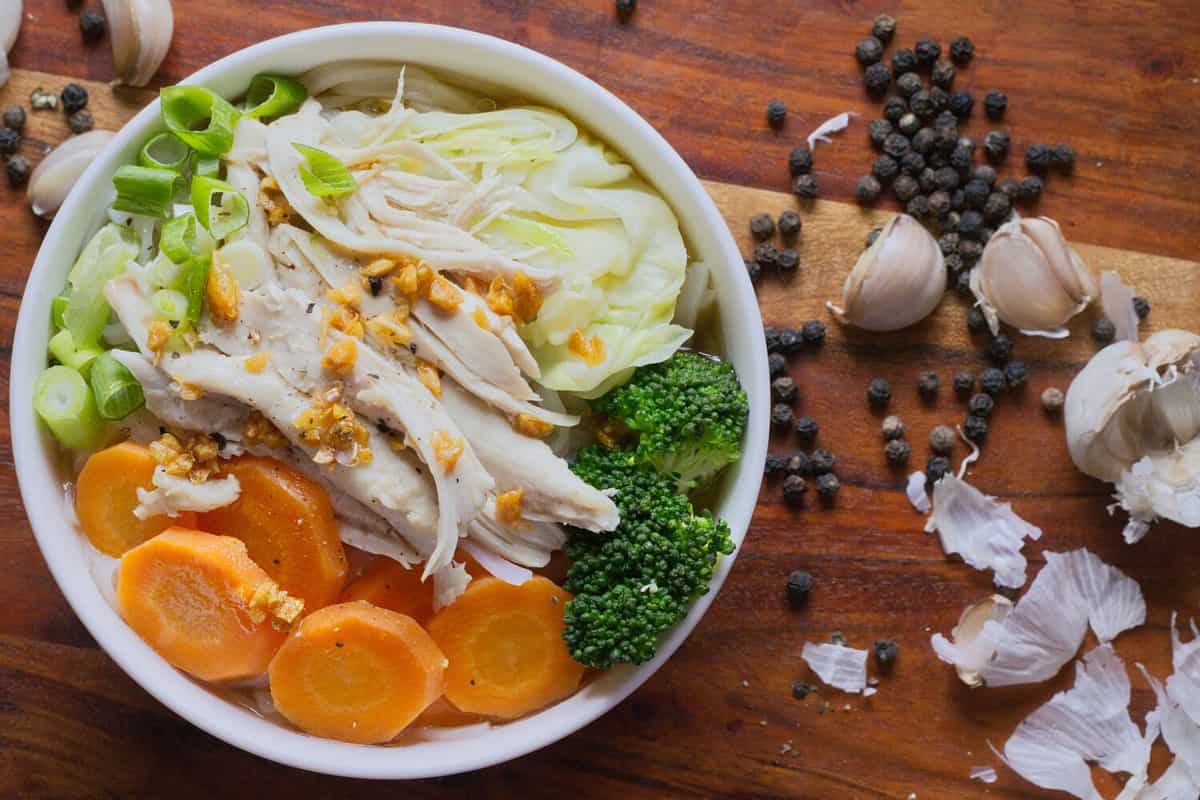
No matter the type of pho you are eating, the herbs, broth, and meat all contain plenty of vitamins and minerals that benefit overall health.
©Wita Design/Shutterstock.com
The Downsides of Pho
Although pho can be very nutritious, there are a couple of downsides to look out for. For starters, pho can be high in sodium. This will vary depending on whether or not one makes their pho at home or uses a prepackaged pho. Prepackaged pho may contain more sodium than homemade versions. Sodium can have adverse effects on overall health, including increasing blood pressure and affecting heart health. To reduce the amount of sodium in the pho, make homemade pho and take note of the sodium content in the bone broth.
Pho can also be higher in calories. Of course, this all depends on the meat used, and beef contains more than chicken. In addition, the various toppings can quickly add up the calorie content. According to FoodData Central, 100 grams of authentic Vietnamese Pho Noodles from Snapdragons Foods LLC contains 367 calories and 2420 milligrams of sodium, which comes out to 2.42 grams.
One of the best ways to enjoy pho without worrying about the extra calories and sodium is by making your own! Below are some delicious pho recipes to try today.
Pho Recipe to Try Today
Print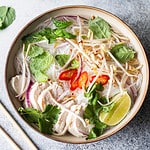
Chicken Pho (Pho Ga)
- Total Time: 45 minutes
Ingredients
- 8 cups chicken broth (homemade or store-bought)
- 1 lb boneless, skinless chicken breasts
- 1 onion, halved and unpeeled
- 1 3-inch piece of fresh ginger, sliced
- 3–4 cloves garlic, smashed
- 2–3 star anise
- 3–4 whole cloves
- 1 cinnamon stick
- 1 tablespoon coriander seeds
- 2 tablespoons fish sauce
- 1 tablespoon soy sauce
- 1 tablespoon sugar
- Rice noodles, prepared according to package instructions
- Fresh herbs (cilantro, mint, Thai basil)
- Bean sprouts
- Lime wedges
- Sliced chili (optional)
Instructions
Broth Preparation:
- In a large pot, combine chicken broth, chicken breasts, onion, ginger, garlic, star anise, cloves, cinnamon sticks, and coriander seeds. Bring to a simmer over medium heat.
Cook Chicken:
- Simmer until the chicken is cooked through, about 20-25 minutes. Remove the chicken and shred it using two forks.
Strain Broth:
- Strain the broth to remove the solids. Return the clear broth to the pot.
Season the Broth:
- Add fish sauce, soy sauce, and sugar to the broth. Adjust the seasoning to taste.
Assemble Bowls:
- In serving bowls, place a portion of rice noodles and shredded chicken.
Pour Broth:
- Ladle the hot broth over the noodles and chicken in each bowl.
Garnish:
- Top the bowls with fresh herbs (cilantro, mint, Thai basil), bean sprouts, and lime wedges. Add sliced chili if you like it spicy.
Serve:
- Serve immediately, allowing each person to customize their bowl with additional lime juice, herbs, and other condiments.
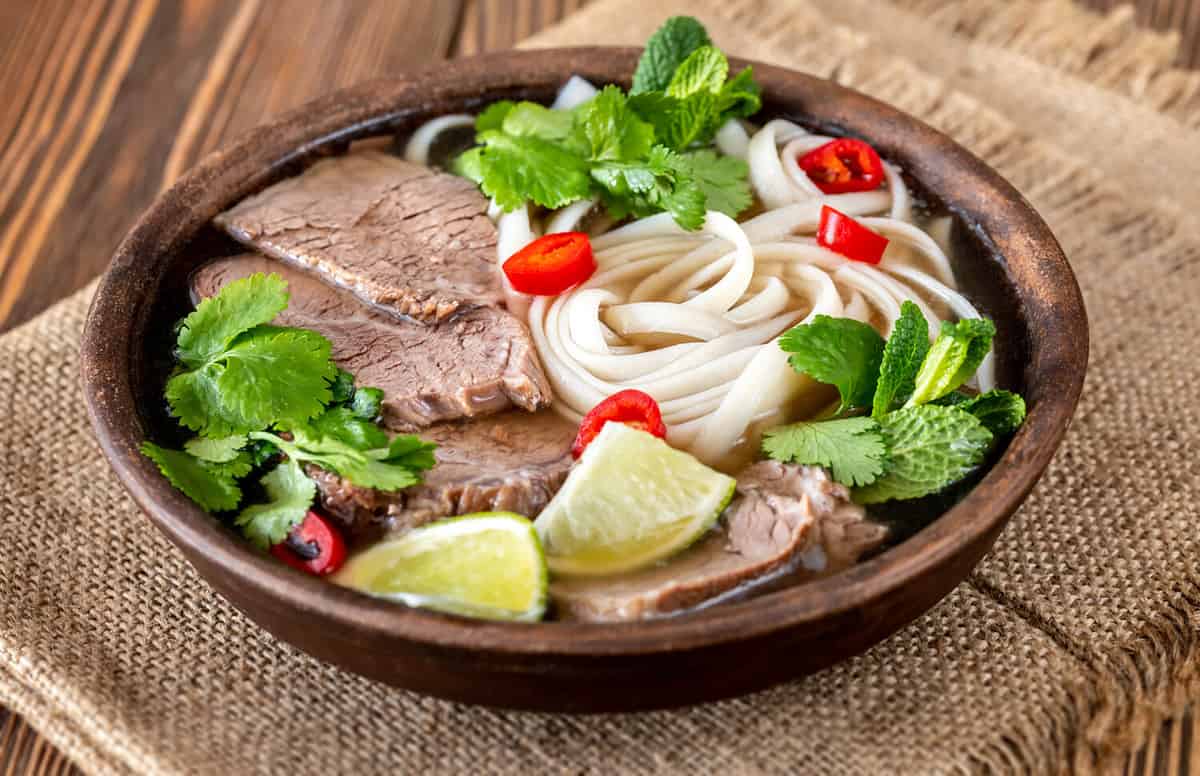
There are plenty of herbs, spices, and toppings to try in homemade pho!
©Alexander Prokopenko/Shutterstock.com
So, is Pho Healthy?
The question remains: is pho healthy? The answer is yes! Pho contains plenty of nutrients and health benefits. These include lowering the risk of heart disease and blood sugar and improving sleep habits and immune function. Pho has numerous impressive herbs that carry plenty of nutrients that we need every day, as well as bone broth that can reduce inflammation and aid in joint health. The type of meat one enjoys in the pho can also carry numerous benefits like protein and help with heart health.
Of course, sodium and calorie content can adversely affect health; therefore, choosing homemade pho over prepackaged is the way to go.
There are so many benefits that come from eating pho. If you are in the mood for a hearty, filling, and aroma-packed soup, try pho today. You may be pleasantly surprised, plus the health benefits do not hurt either!
The image featured at the top of this post is ©Chzu/Shutterstock.com
